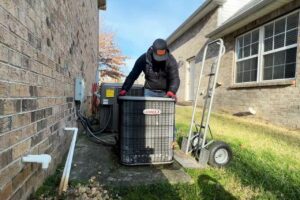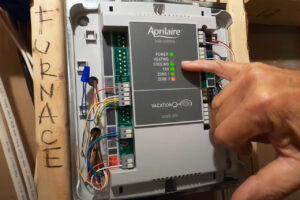 Homeowners rely on heating and cooling systems in their homes to ensure a comfortable indoor environment for themselves and their loved ones. However, achieving the perfect balance of comfort throughout the property is quite difficult while keeping the energy costs at a minimum. HVAC zoning helps homeowners achieve the proper comfort while ensuring low energy consumption costs. Consider consulting experts from The Heating Co for advice on optimizing your HVAC system for maximum efficiency and comfort.
Homeowners rely on heating and cooling systems in their homes to ensure a comfortable indoor environment for themselves and their loved ones. However, achieving the perfect balance of comfort throughout the property is quite difficult while keeping the energy costs at a minimum. HVAC zoning helps homeowners achieve the proper comfort while ensuring low energy consumption costs. Consider consulting experts from The Heating Co for advice on optimizing your HVAC system for maximum efficiency and comfort.
The purpose of HVAC zoning is to divide your home into multiple sections with individual thermostats. This helps ensure a comfortable temperature without affecting the entire house. In this guide, HVAC experts from AC install, Houston, TX will guide you through the tips and tricks of zoning systems.
5 Tips to Improve Comfort & Save Money Through HVAC Zoning
Ensuring proper HVAC zoning is an efficient way of making your home comfortable without increasing the energy bill significantly. Here are a few tips to help you improve comfort and save money with the help of HVAC zoning.
1. Divide Zones
 The very first tip for maintaining a comfortable environment indoors is to divide the entire home into zones. To do this, identify the areas in your home which require different temperatures needs for comfort and separate them into specific zones.
The very first tip for maintaining a comfortable environment indoors is to divide the entire home into zones. To do this, identify the areas in your home which require different temperatures needs for comfort and separate them into specific zones.
Typically, rooms with big windows or doors that allow direct sunlight require more cooling than rooms or areas with proper shading. Dividing the entire room into small zones will help you to control the temperature in each area specifically. This temperature control is achieved by relying on individual thermostats for each zone.
As a result, the specific zone will meet the temperature set on the thermostat without affecting the temperature of the entire home. This will not only ensure a comfortable environment but will also keep the energy bills down.
2. Rely On Dampers
Dampers are an efficient way of ensuring a balanced temperature throughout the home. It is a valve that is installed in the ductwork of the house. The purpose of the valve is to control the flow of air from the air conditioning or heating systems to different zones of the house.
By installing dampers in the ductwork of your home, homeowners can easily increase or reduce the airflow to specific zones. This will help you to balance the temperature without consuming too much energy. You can either adjust the dampers manually on your own or set up an automated system. This will reduce energy waste by a notch and help to save money on heating or cooling.
3. Use Smart Thermostats
Smart thermostats are a great addition to the heating or cooling system industry. These are programmable thermostats that can help homeowners to control the air conditioning or heating system with the help of their smartphone or smart device. You can program these thermostats to adjust and control the temperature in each zone of the house.
With smart thermostats, you can set the bedroom to be cooler than the living room or vice versa. These thermostats will make sure that you do not have to adjust the temperature on your own every time.
4. Size The Zones Properly
When dividing the home into zones for HVAC control and temperature, homeowners often miss out on an important point. Sizing the zones properly is a crucial point of zoning to make sure that the energy is being used efficiently throughout the home. If the zone is bigger, the energy consumption will be higher to heat or cool the area.
On the other hand, installing individual thermostats for zones that are too small is not a cost-efficient option. To size the zones of the home properly, focus on the temperature requirements. You can also take help from AC installation and maintenance experts to know more about zoning sizes.
5. Monitor Energy Usage
Last but not least, monitoring the energy usage of your home is an efficient way of tracking your monthly consumption and energy bill. This will help you to identify any gaps or leaks in the home which result in additional energy consumption than required.
Not only that, but it will also ensure that you can easily identify areas or zones in the home where you can save money on energy. By keeping track of energy usage, homeowners can identify the zones consuming high amounts of electricity. It will also help them to adjust the zones according to their requirements and preferences.
FAQs
1. How Much Does It Cost To Install HVAC Zoning?
There are several factors that play crucial roles here. The overall cost relies on the size of the house, layout, type of air conditioning or heating system, and so on. However, as an estimate, the cost typically ranges between $2500 to $3000.
2. Is It Possible To Install Zoning Systems On Your Own?
While it is said that installing zoning systems as a DIY project is possible, HVAC professionals do not usually recommend it. This is because the installation process can be quite complicated, and mistakes in the procedure will cause damage to the home.
3. Can HVAC Zoning Be Done In An Existing HVAC Design?
Yes. However, the upgrade will cause a significant amount of money, and it will be a complicated project to manage. The entire process will typically cost more than installing HVAC zoning in a renovated or new home. On top of that, component upgrades, system changes, and so on will increase the cost and complexity further.
Bottom Line
Every homeowner wishes to have a relaxing temperature and atmosphere in their homes. Oftentimes, HVAC systems fail to maintain a consistent temperature throughout the house due to the size, layout, HVAC type, and so on. HVAC zoning is the perfect solution to help homeowners get rid of uneven heating or cooling throughout the house.
Make sure that you divide the zones properly and size them according to your needs and preferences. Rely on dampers and smart thermostats to control the temperature efficiently and save money at the same time. You can take help from HVAC professionals of AC install, Houston, TX to ensure accurate HVAC zoning.
